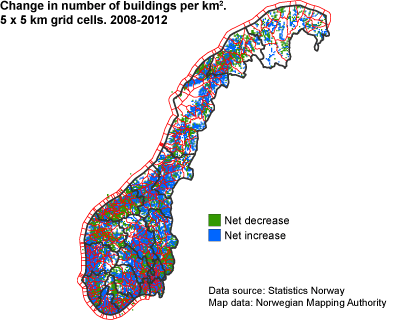Content
Published:
This is an archived release.
Major changes in building stock
A register count of building stock shows that there has been a net increase of 457 942 buildings in the last 10 years. Seventy-five per cent of the growth has been within other than residential buildings.
Detached houses are still the most common type of residential building, with 1 137 938 buildings, or 77 per cent of all residential buildings. However, the number of detached houses has only had a net increase of 4.5 per cent, while other types of residential buildings have increased by more than 20 per cent.
Fewer buildings in industrial sector
Industrial buildings is the group of buildings by type that has had the greatest net decrease in the last 10 years, with 10 512 fewer buildings. This is a decrease of 9.3 per cent. The number of agricultural and fishery buildings have however remained almost the same.
There are almost 4 million registered buildings in Norway.
A mapping of buildings within 5 x 5 kilometre grid cells shows that there has been major geographical changes in the last five years. Of the grid cells with buildings in the period 2008 to 2012, almost 14 per cent have experienced a net decrease in number of buildings. Most of these grid cells are situated in rural areas in the North of Norway and inland in Southern Norway. Statistics on grids can be downloaded from MapBank (In Norwegian).
Basis for statisticsThe statistics are based on data from the data register (Matrikkelen). The municipalities record data in the Matrikkel. All buildings in Norway larger than 15 square metres are recorded in the register with a code for building type and coordinates. The statistics include buildings that are demolished, burnt down or otherwise non-existent, where these are not reported to the authorities. Connected units are recorded as separate buildings when the units can be demolished independently of each other. A single dwelling in row houses and in semi-detached houses is recorded as one building. |
Causes for changes in building stock
|
More statistics on gridsStatistics Norway aims to publish more statistics on grids. Statistics on grids are made according to a national standard grid for official statistics. For more statistics on grids and information about grid cell sizes etc, see the home page for grid statistics (In Norwegian). |
More figures are available in StatBank .
Contact
-
Jens Mathiesen
E-mail: jens.mathiesen@ssb.no
tel.: (+47) 40 81 13 98
-
Mona Takle
E-mail: mona.takle@ssb.no
tel.: (+47) 40 81 14 12

